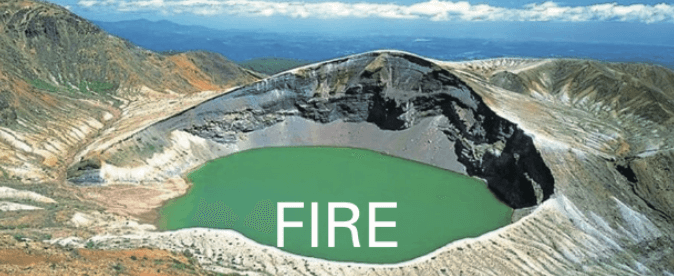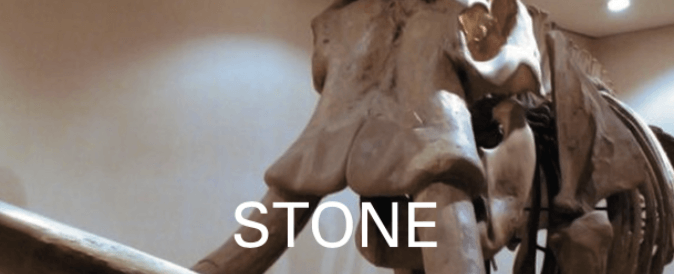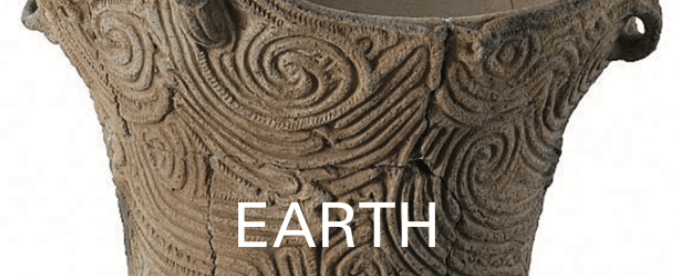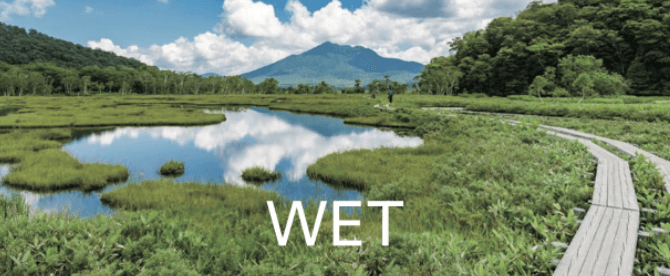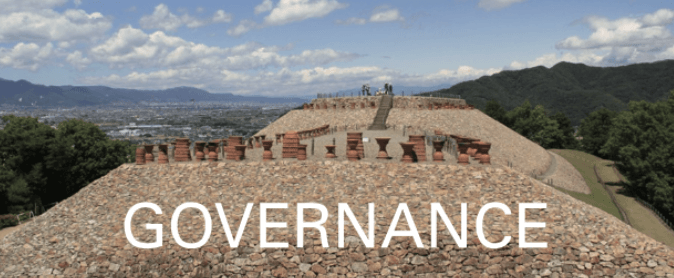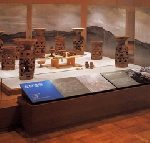
This museum is located at the Furu site, which is the largest archeological site around Tenri City. This museum restored the ceremony from the ancient time of the Tumulus period (the 3rd– 7th century), with clay images from the Furu site and others.
The Furu site is compound ruins, since the Paleolithic Period, which is in the area of approximately 2 km east-west and 2 km north-south, interposed the Furu River and is mostly within the Tenri sect’s facilities. A chief’s house, workshop, and festival hall were set up in this site from the end of the Yayoi period (the 4th BC – 3rd century), to the Tumulus period (the 3rd– 7th century).
It seems this site was derived from the Mononobe clan, a powerful military clan by the 6th century, which was based here.

“This is a miracle: Jomon and Yayoi ware are still alive! ” -Tsuzura Ozaki is a peninsula at northern Lake Biwa, the largest freshwater lake in Japan. This site is at the floor of the lake, with water depth of 10 ‒70 meters, at the start of this peninsula. This lake floor has preserved well the relics spanning over 15,000 years. They have even kept their original color.
There is no river that causes sedimentation in the surrounding area, and the ancient terrain remains the same. There is the discovered site on the bottom of the lake. However, it is a mystery why the Tsuzura Ozaki Lake Floor Site submerged. This museum exhibits and introduces the raised potteries from the Jomon period (16,000 years ago – 3,000 years ago) and from the Yayoi period (the 4th century BC – 3rd century).

This museum is located in the suburban hillock of Wakayama, which introduces the history of this place. Here a keyhole tomb was built during the Tumulus period, 1,750 – 1,400 years ago. The largest group of tombs in Japan were also built which indicates that this place used to flourish as a gate to foreign culture.
This museum exhibits a clay image in the shape of a bird to decollate Tumulus as a sacred place, a man-shaped clay figure with two faces, and Koroku, an arrow holder-shaped clay figure.
You can understand this place which was the core place of Kuni no Miyatsuko, the regional administrator of the Ki clan, which had a connection with the Korean Peninsula.

“You see the Continental style arriving in the Yayoi Period” -This museum conveys the ancient culture of Hyogo Prefecture. It is a lively place, with the carefree laughter and conversations of children. This museum neighbors the Onaka Site. There, you can see powerful, life-sized dioramas about the marine trade with Continent, via the Setuchi Inland Sea.
A full-scale ancient ship and a king’s coffin made of stone from Harima Province are exhibited and pit dwellings are restored in the adjoining historical park, “Harima Onaka Ancient Village.” At the entrance, earthenwares excavated in this prefecture are lined up by days, from the Jomon period (16,000 years ago – 3,000 years ago) to the Edo period (1603 – 1868).
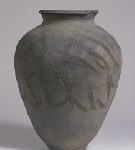
Suzu ware was produced in the vicinity of Suzu City from the end of the 12th century to the end of the 15th century. Suzu ware was the representative ware in the Medieval age and then suddenly disappeared. It inherited the technique of Sue ware, which had excellent water holding properties, and came from the Korea Peninsula in the Tumulus period (the 3rd– 7th century). Suzu ware was baked without glaze.
The museum introduces “phantom antique pottery”, through the exhibition of decorative vases such as “Suzu Kushime Kesadasuki mon ko, a Vase of Suzu Ware with a pectinate pattern and cross band pattern”, which was surrounded with a ripple pattern made by comb teeth, and “Shoin ware” in the end of the Edo period (1603 – 1868).
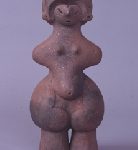
“Here, you will meet the National Treasure, Jomon Venus.” -Here you will see the Clay figure ,Dogu of the Jomon Venus, from the Tanabatake site in Chino. This Dogu, from the middle Jomon period, 5,000 – 4,000 years ago, is a large one, measuring 27cm tall and weighing 2.14 kg. This Dogu has very few broken pieces, unlike most Dogu found from that period.
Here you will see the Clay figure ,Dogu of the Jomon Venus, from the Tanabatake site in Chino. This Dogu, from the middle Jomon period, 5,000 years ago, is a large one, measuring 27cm tall and weighing 2.14 kg. This Dogu has very few broken pieces, unlike most Dogu found from that period. Of course, SHE is Venus! The museum is located in the historic park of the Togariishi site at the foot of Mt. Yatsugatake and Mt. Kirigamine, and displays cultural assets and materials excavated from Jomon period sites (16,000 years ago – 3,000 years ago).

This area is a watershed that divides the Pacific Ocean and the Japan Sea in the center of Nagano Prefecture. Since about 10,000 years ago, the Chubu Mountains region had a unique culture and interacted with the Kant-East Japan, Kansai-West Japan, and Japan Sea sides- north Japan. In the Hiraide remains, 290 houses were found in a large village from the Jomon period to the Heian era (794 – 1192).
Hiraide museum possesses about 20,000 pieces of earthenware and stoneware excavated from the sites of a village that had lasted for 5,000 years, and exhibits the largest tile tower in Japan, from the later part of the Nara period (710 – 794).
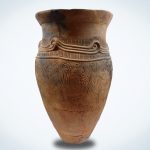
“A Settlement Compound spanning over 4,000 years“ -This site is one of the great settlement compounds from the Jomon period, 5,000 years ago, to the Heian period, 8th-12th Century. There are 20,000 excavated artifacts, including earthenware and stone implements. This area was a great central location through the watershed of central Japan, from the north to the south.
The Hiraide Iseki site is located on the depositional plain of the Narai River, originating from Mt. Kiso-Komagatake. Hiraide Museum is located in a hilly area overlooking the site, which possesses about 20,000 items excavated from this site. Nagano Prefecture was thought to be out of the distribution range of Dotaku, bronze bells, but discovering Shibamiya Dotaku of this museum’s collection, overturned that common sense. The discovery showed that Nagano had contact with the Tokai region facing Pacific Ocean.

The history exhibition room of this museum, exhibits the full-scale restored residence and others to convey the history of Ehime from the primitive age to modern times.
Hoketsu Pass (436m height), in Ashizuri-Uwakai National Park, looks down on terraced fields, Uwa Sea colored azure, and the Rias coast, with its striped patterns. It has long views of Kyushu Island.
Pottery and other objects from the Jomon period (16,000 years ago – 3,000 years ago), were excavated at Hoketsu Pass. It also indicates an ancient connection with the Osumi Peninsula in the southern Kyushu Island.

Mt. Fukuchiyama, one of northern Kyushu’s iconic mountains, is formed by an ancient stratum with granite piled. The slope of Kokura Kitakyuushu is gentle and the slope of Fukuchi Town is steep. At the steep slope of Fukuchi Town, there is Agano Valley, the source of the Fukuchi River. The center of the valley has the Shiraitonotaki Water Fall, which contains a lot of strange rocks along the 3km ravine.
In the early modern days, the Agano tea ware, which had a dominant influence in the world of tea pottery in Japan, is produced. The Agano tea ware is sintered in the red pine of Mt. Fukuchiyama, and its character is taken from the atmosphere of this valley.
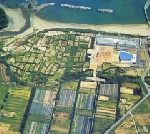
A cycad plant community spreads over this site where many Kaneku-type pottery peculiar to the Amami Archipelago, from the 7th to 11th centuries, were excavated. Cycads grow on rocks near the coast, become fertilizers and fuels, become windbreak and land borders, and are emergency food during famine.
Although the landscape of cycad field used to be seen throughout the Amami archipelago, it has almost disappeared due to the land improvement project.That traditional landscape exists over a large area on this site.
